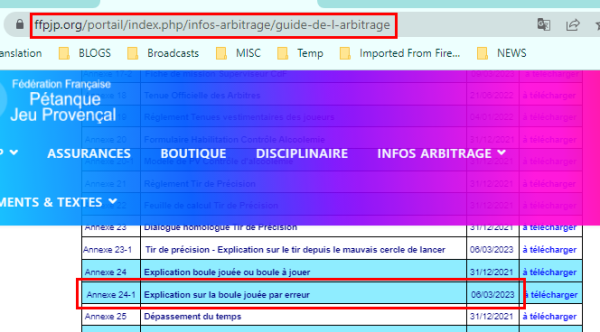updated 2023-08-23
A boule played out-of-turn is a boule that was played when a team mistakenly believed that they did not have the point, and that it was their turn to play.
For a long time, there has been serious debate about what should be done when this happens. Some have argued that a boule played out-of-turn was played “contrary to the the rules” and that Article 24 therefore gives the opposing team the option to declare it to be dead. Others have argued that a boule played out-of-turn was NOT an infringement of the rules but simply a mistake; the boule(s) should be left where they are and play should continue.
As of March 6, 2023, this debate has been settled by a ruling by the FIPJP. It is now official— a boule played out-of-turn is simply a mistake; it should be left in place and play should continue.
I don’t know if this ruling can be found on the FIPJP web site. A French version of it can be found on the FFPJP Guide de l’Arbitrage, and the Oceania Confederation posted a French and English version which you can read HERE.
The … ball played by mistake will be valid until the end of the mène.
This ruling made its way to the “Ask the Umpire” Facebook forum on May 4, 2023. In two separate posts (HERE and HERE) Tony Kidd, Trudy Bishop, Allen Cassady, and Andries Wijand all asked roughly the same question:
If Team B gains the point, but does not measure and (thinking that they have not gained the point) plays a second boule, what is the penalty?
Mike Pegg’s answers (which I have combined and compressed for the sake of readability) were—
The penalty is that Team B has wasted one of its boules. No boules are removed, and play continues. Team B of course should have checked [to verify that they were not holding], but so should team A to be sure they are still holding. If neither team checks to see who is holding, they are both in the wrong. Team B’s second boule remains valid, and they are at a disadvantage having played a boule they didn’t need to play.
It is nice to have this old thorn in the side finally pulled.
Since I first wrote this post I’ve seen several translations of the French text of the memo. They are all adequate but (in my opinion) none of them is very good. So, for what it’s worth, here is my own translation. I have inserted text in [square brackets] for the purposes of clarification of the text.
Explanation of a boule played by mistake
FIPJP decision – 06/03/2023
1 – THE SITUATION EXPLAINED
• Team A plays its first boule.
• Team B points. Team B, thinking that it has not taken the point, plays a second boule which takes the point.
• In doubt about the situation, both teams measure. It turns out that team B had taken the point with its first boule, so team B has 2 points.
2 – THE DECISION
The second boule played by mistake is valid until the end of the mene.
[3 – THE REASON FOR THIS DECISION]
Why is this?
First: the rule does not prohibit a team from playing when it has the point, as long as the measurement has not been made.
Second: such an action typically falls within the scope of an error already sanctioned (by the fact that the team in question is, as a result, deprived of a boule).
Finally: the cancellation of this second boule played by mistake is unenforceable [French: inapplicable].
[Why is the cancellation of this second boule unenforceable?]
* Firstly, if the players don’t immediately realize the error, how is the umpire going to decide when other boules have been played and have displaced one or other of the disputed boules when, by definition, no measurement has been made on them?
* When a dead boule moves other objects, these can be put back in place if marked. A problem immediately arises if these other objects move the jack or one or more boules, especially as (as we all know) markings are rarely accurate to the nearest millimeter.
* It can even happen that as many as nine boules are played after the second boule in question before the players discover that their first boule played had the point!
[4 – CONCLUSION]
The only valid measurement for awarding points is the one that is eventually done at the end of the mene, regardless of the order in which the teams played.


